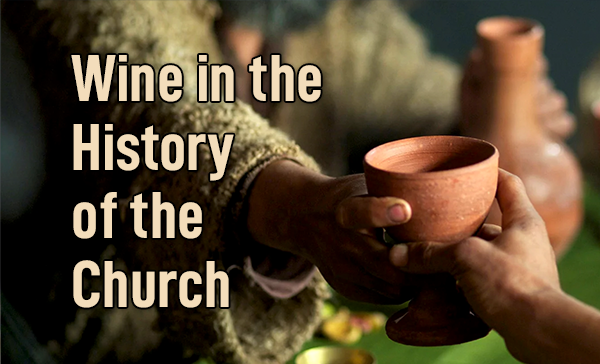
Most of us are aware of the winding story of alcohol in history. In my art and literature college days, I remember seeing the tragic impact of gin on English culture in the graphic paintings of Hogarth and references in early novels (Henry Fielding, Tobias Smollett, Daniel Dafoe) and social commentators of the day (including Samuel Johnson). You don’t have to be an English Major to know that the stories of Charles Dickens are filled with references to the power of alcohol to wreak havoc on society (see A Tale of Two Cities and Hard Times). Alcohol’s destruction runs right through the history of America, even leading to an unlikely partnership between orthodox Christians, the liberal church, and political progressives in the first part of the twentieth century, Prohibition. Then again, who are we kidding? Some of us have witnessed within our own families and our own lives the power of alcohol to disintegrate everything it touches.
It is very challenging to reflect upon the role wine may or may not have in Christian worship. According to the Bible, wine and bread were the elements of the Lord’s Table in the New Testament church (see Wine in the story or redemption). Our question is practical: how was wine been used in the life of the Christian church beyond the New Testament era to the present? In the Bible, wine can be used in ways pleasing to God, and displeasing. Has wine had a place in Sunday morning worship through the ages?
From the time in which the last book of the New Testament was written, approximately AD 90, all the way to AD 400, every written source indicates that alcoholic wine was used in the religious worship of the church. This is attested by pastors like Justin, Irenaeus, Cyprian, Basil, and Hippolytus, men whose understanding of Scripture we tend to rely upon. It is true that historical documentation is not exhaustive; not every church matter is addressed by documents that we have. Of the documents we have, the use of wine is overwhelmingly assumed. There was an odd debate in the fourth century in which an unorthodox body called the Encratites (or Severians) forbade, among other things, wine. For this, and for other more serious reasons, the orthodox church condemned the practices of this sect in 382.
Moving into the period from 400 to 900, things remained the same. There were three liturgies or worship structures in the Christian church during this time. The Latin (Roman), Greek, and Syriac liturgies were usually determined by geography and culture but, in all three, the elements of the Lord’s Table were always bread and alcoholic wine. The first real debate over wine happened in 692 when pastors in Armenia were reprimanded for not diluting the wine with water (Trullan Synod). There was a movement to add water to the wine because, when Jesus was pierced in the side, the Bible says His blood was mixed with water (Jn. 19.34 with 1 Jn. 5.6).
The Reformation was an era of enormous change in the life of the church and filled with numerous theological debates. Nevertheless, debates about wine were absent. Wine was used exclusively at the Lord’s Table even by Anabaptists who, while they sought change to the sacrament of baptism, did not seek to change the elements of the Lord’s Table. Reformers of every stripe assumed that wine was the proper element. When the Reformers did disagree about the Lord’s Table, it was usually about the presence of the body and blood of Jesus, and never about the use of wine. The Reformers agreed with the stream of church history of using wine.
For English Puritans and early Presbyterians, the practice of wine was also exclusive. A rare public statement from the Church of England about the use of wine was only to give special permission for ministers to use wine undiluted with water, which was the practice of the earlier Reformers.
This was still the situation with the arrival of the Mayflower in the American colonies. The Arabella arrived with 10,000 gallons of wine and three times more beer. Wine was exclusively used for the Lord’s Table by every congregation of Early America. Lord Baltimore, John Winthrop, William Penn, German pietists, Rhenish refugees, Huguenot (French Protestant) settlers, and Californian missions not only used wine at the Lord’s Table, they planted vineyards. American Puritan Increase Mather, and Baptists John Gill, John Dagg, and James Petigru Boyce published on the topic, citing the value of wine at the Lord’s Table. Over the years, large denominations and independent churches all persisted unapologetically in their use of wine. The Baptist Confession of Faith (1689), the Southern Baptist Abstract of Principles (1859), and the New Hampshire Confession of Faith (1833) all commended wine. Even the Baptist Faith and Message (1925) commended wine until 1963, when “fruit of the vine” replaced “wine.” Baptists, Elijah and Joseph Fay founded the western New York wine industry in 1818 and, years later, Episcopalians and Lutherans did the same in the Midwest.
The greatest shift in practice came during Prohibition. As early as 1774 the Wesley brothers advised members of Methodist societies to refrain from drinking alcohol as it was the source of many social ills. All the while they targeted distilled spirits like gin and never intended change to the Lord’s Table. As Methodists in England and America began promoting temperance societies in 1826, they excluded the Lord’s Table. It was very slowly that temperance began to shift from moderate use to personal abstinence to total abstinence, the latter finally impacting the Lord’s Table.
At the 1833 National Temperance Convention in Philadelphia, the vote for total abstinence failed. Three years later, it passed, but the church was divided. In 1841 the Primitive Methodist Church prohibited the use of wine at the Lord’s Table, but in the same year the Wesleyan Methodist Church prohibited the use of juice. In 1869, Thomas Bramwell Welch, a communion steward at his home church in Vineland, New Jersey, invented a method of pasteurizing grape juice so that juice could be used at the Lord’s Table even when grapes are not in season. Most American churches, including his own, continued to use wine at the Lord’s Table as their ordinary practice. His son began marketing Welch’s pasteurized juice just as the newly-founded Woman’s Christian Temperance Union (WCTU) began to target the Lord’s Table in 1876.
Inconsistencies abounded. From their founding the Disciples of Christ opposed alcohol but used wine at the Lord’s Table; during the temperance movement they adopted total abstinence. The original practice of the Church of the Nazarene, Assemblies of God, and many other holiness churches included using wine at the Lord’s Table. It was a different matter after the temperance movement. Latter-Day Saints were avid producers of wine, but in 1897 removed it from the Lord’s Table.
The shift in practices at the Lord’s Table was varied and complex. The move from moderate use to personal abstinence to total abstinence often coincided with drinking as a social taboo, distrust of the upper-class (wine consumers), fear of intellectualism (secular humanism), abuse of spirits by the urban poor, anti-industrialization, breakdown of traditional authority structures, and the unwelcome presence of immigrants from Europe. In addition, political Progressives related alcohol use to capitalist-led exploitation. Finally, the Volstead Act enforced Prohibition from 1920 to 1933, though it permitted the use of wine “for sacramental purposes” or “religious rites.”
Most culturally dominant religious bodies in America like Congregationalists, Presbyterians, Baptists, Methodists, Episcopalians, and observant Jews, continued to use wine at the Lord’s Table. To many of them, Prohibition posed no interruptions at the Lord’s Table. Even as church members chose personal abstinence, wine was offered at the Lord’s Table.
This history matters. Has wine had a place in Sunday morning worship through the ages? Most certainly. Wine was used at the Lord’s Table with virtually no interruption apart from early twentieth century America. This is undeniable. But within the unique scope of recent American history, juice has also had a role at the Lord’s Table. This, too, is undeniable. Wine and juice trace a different lineage in church history but, as American Christians, it should be no surprise to see both at the Lord’s Table today.







